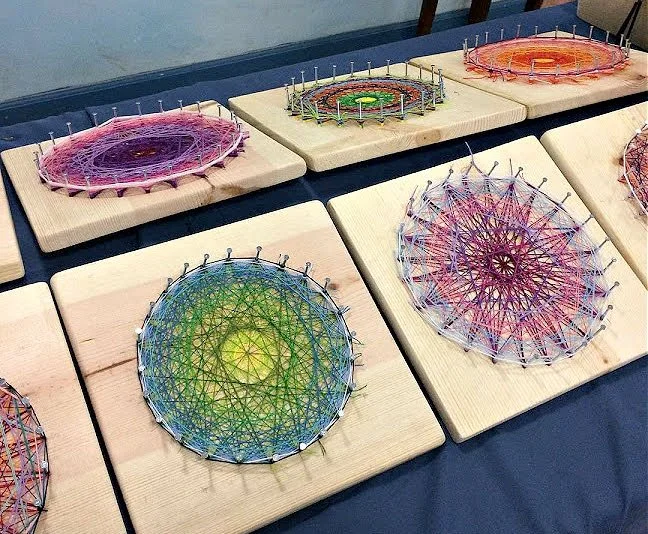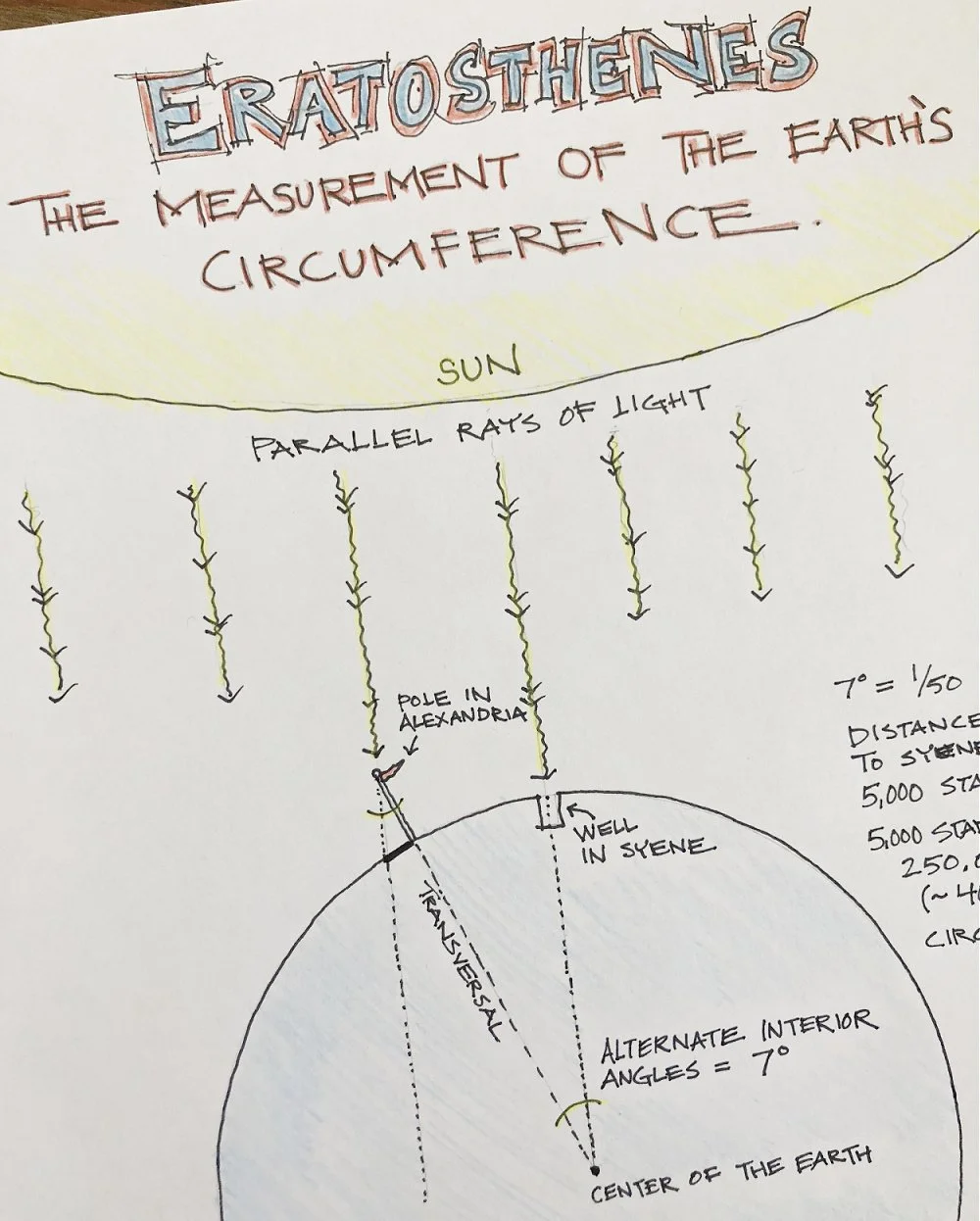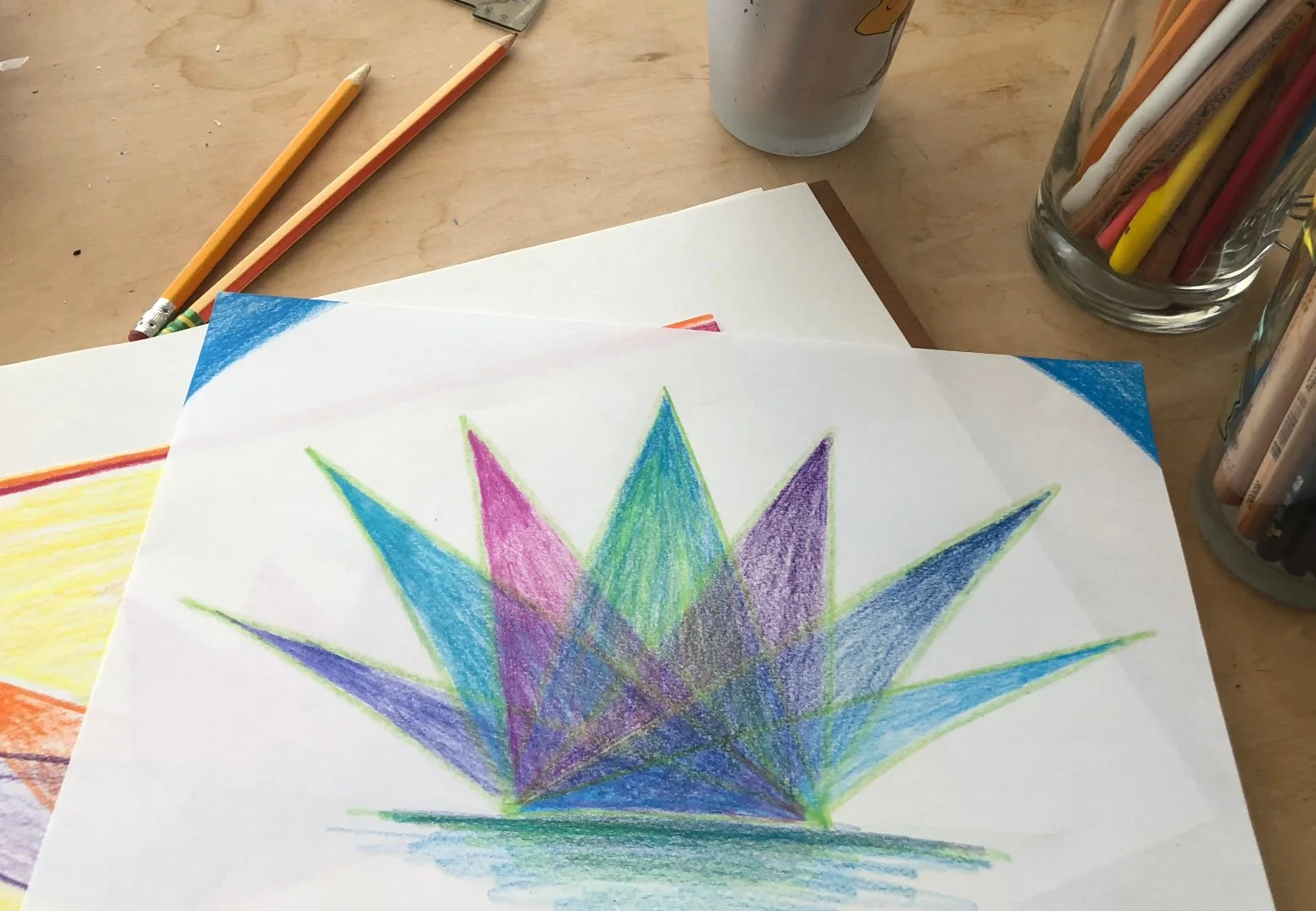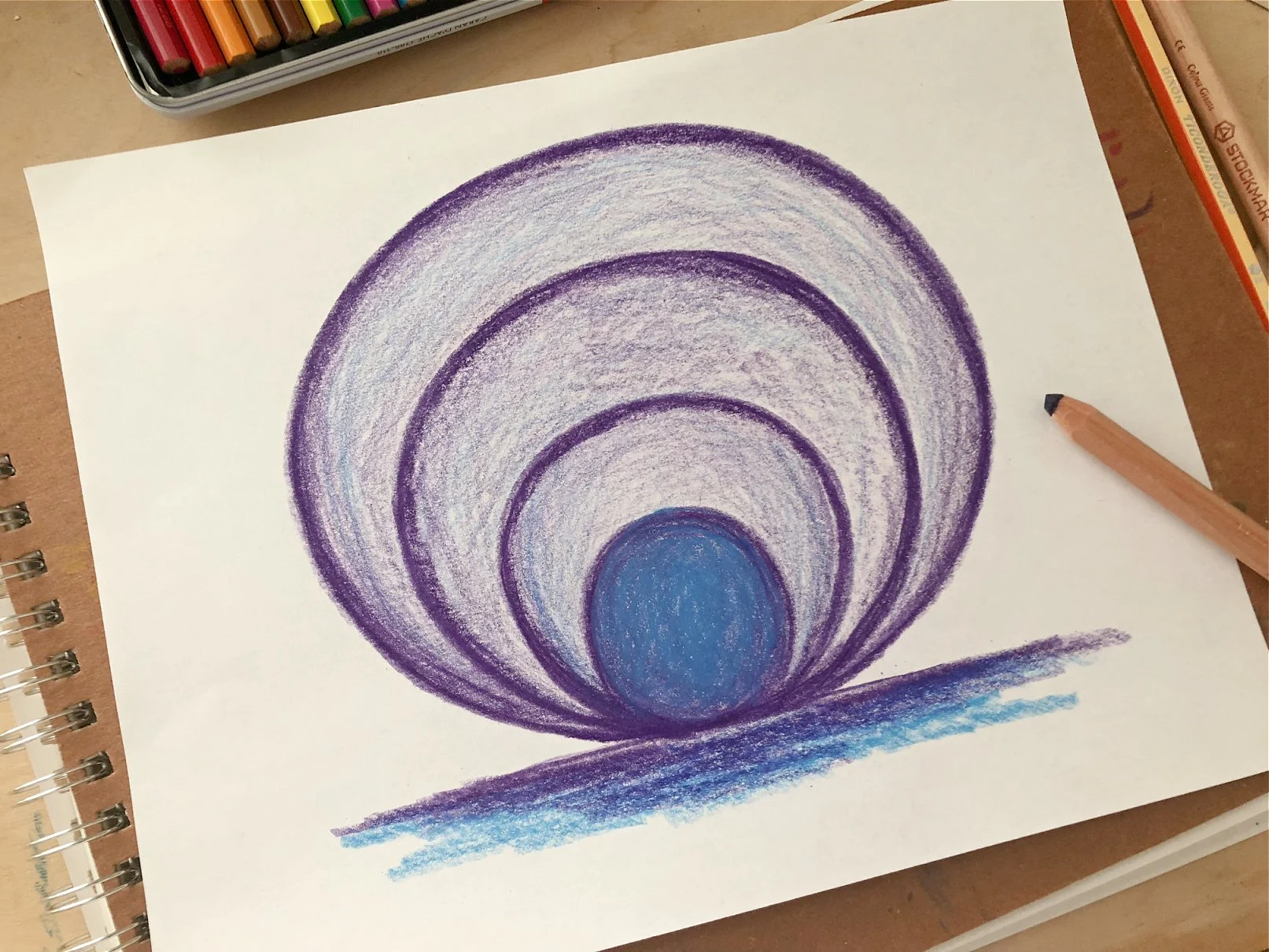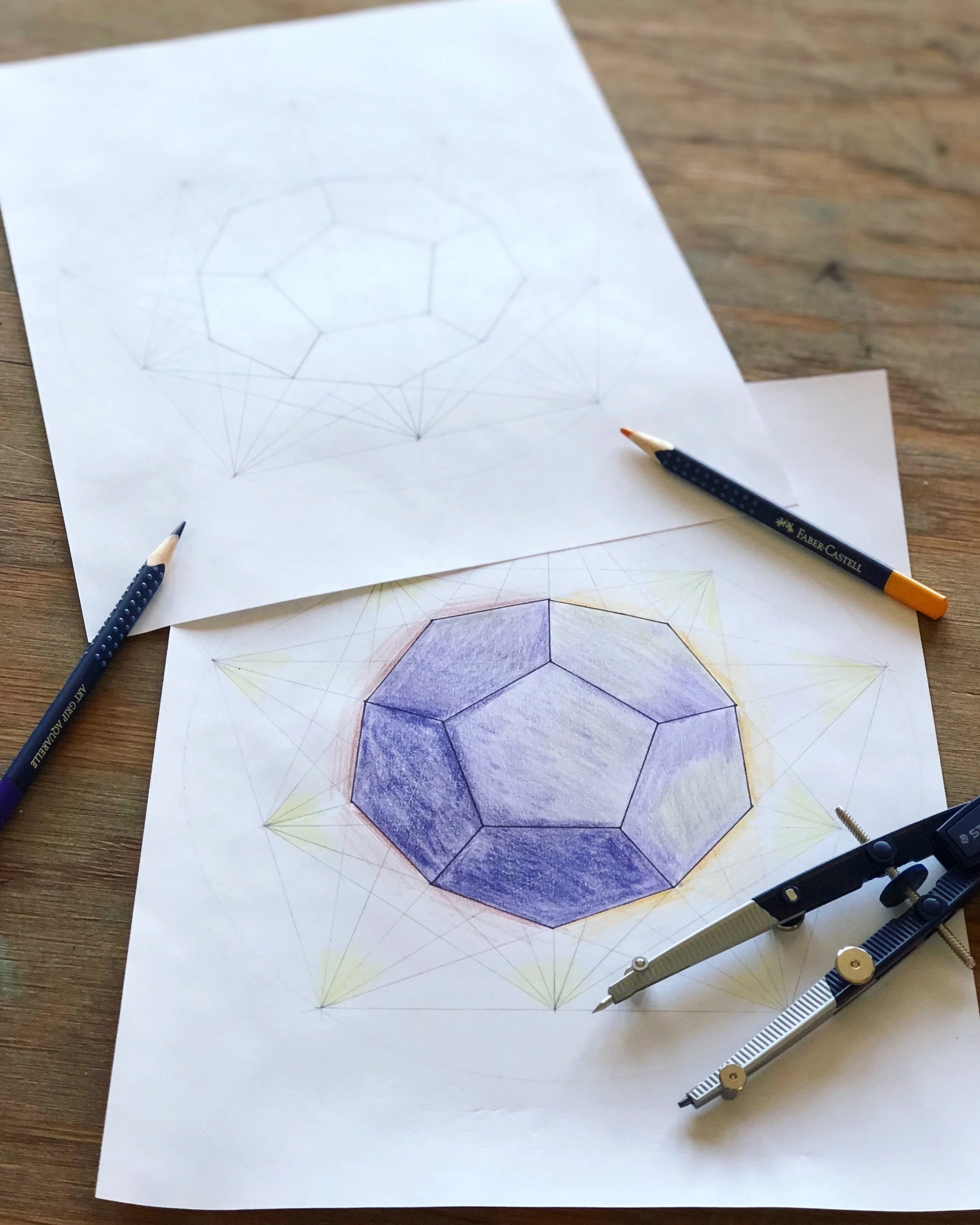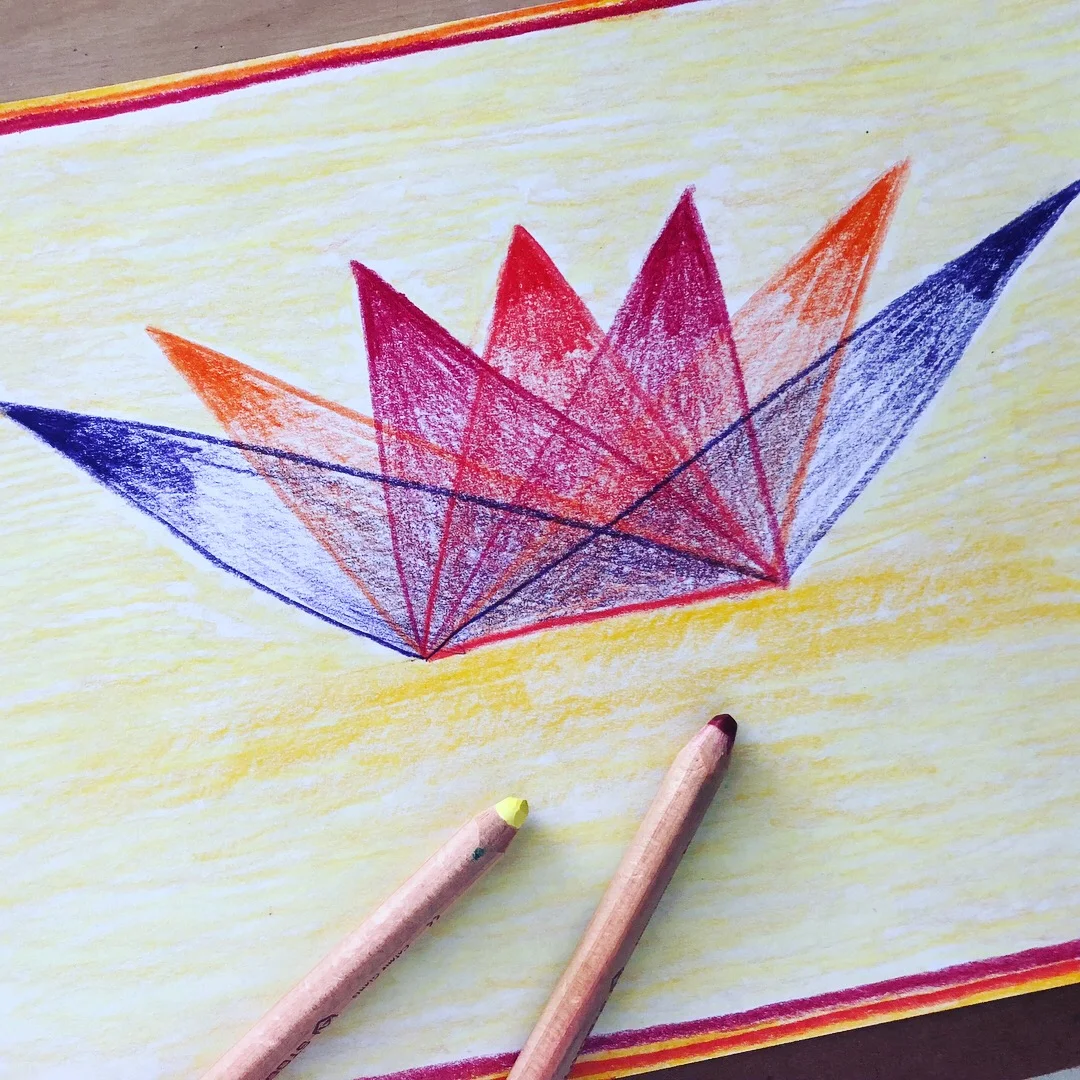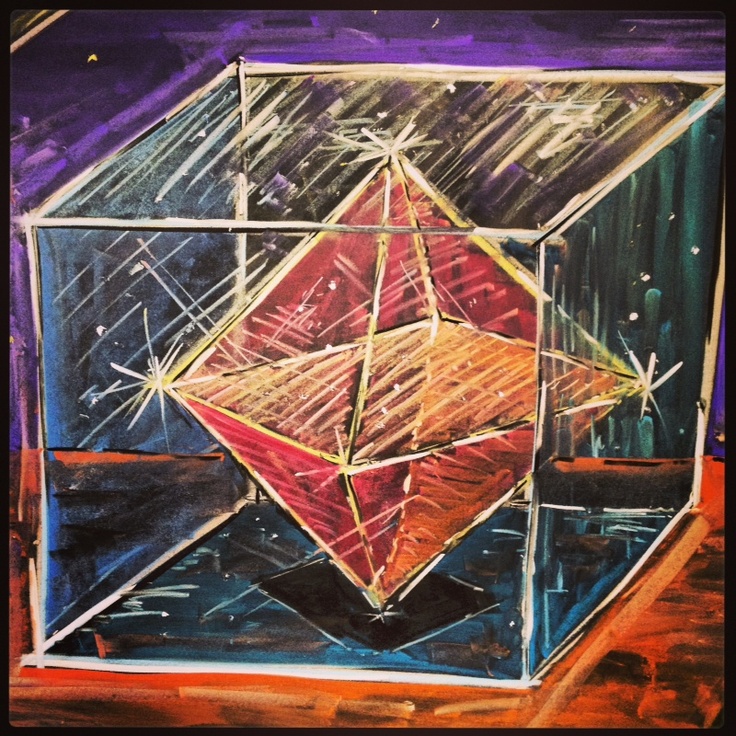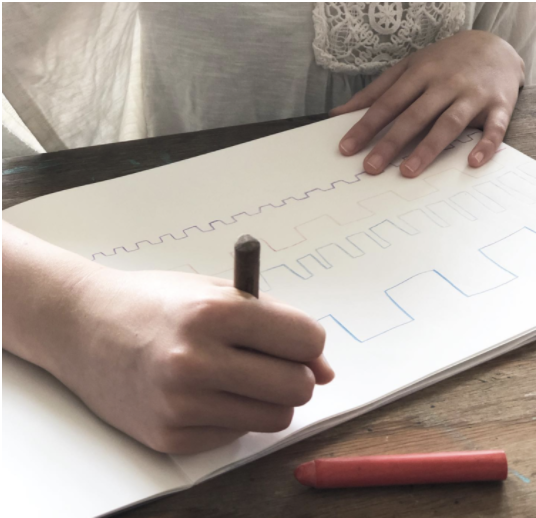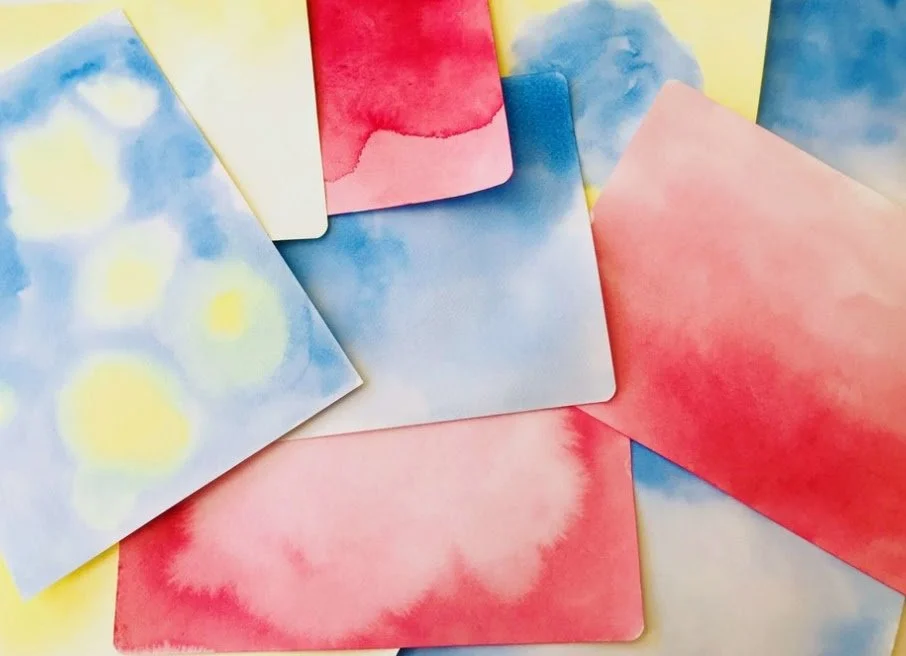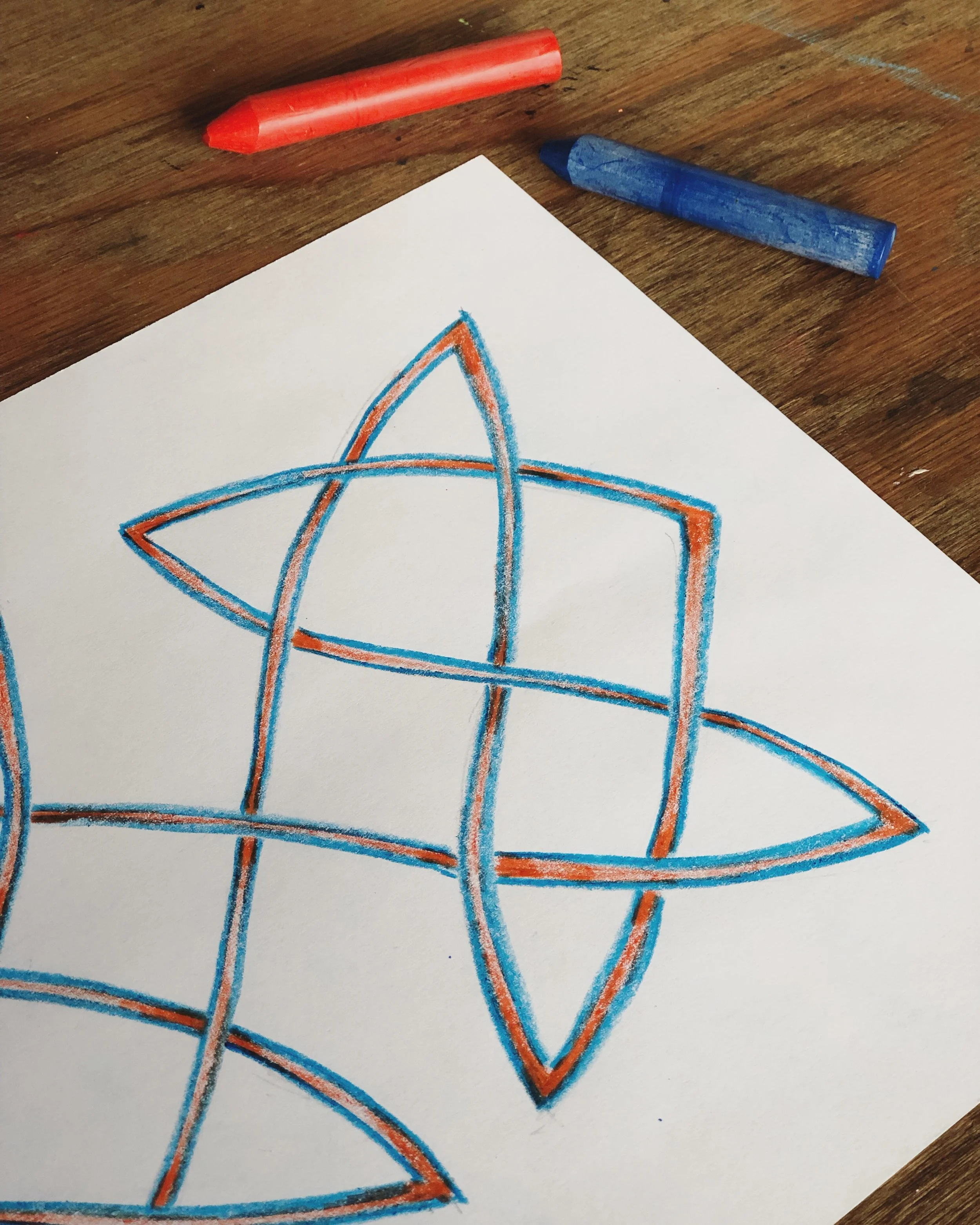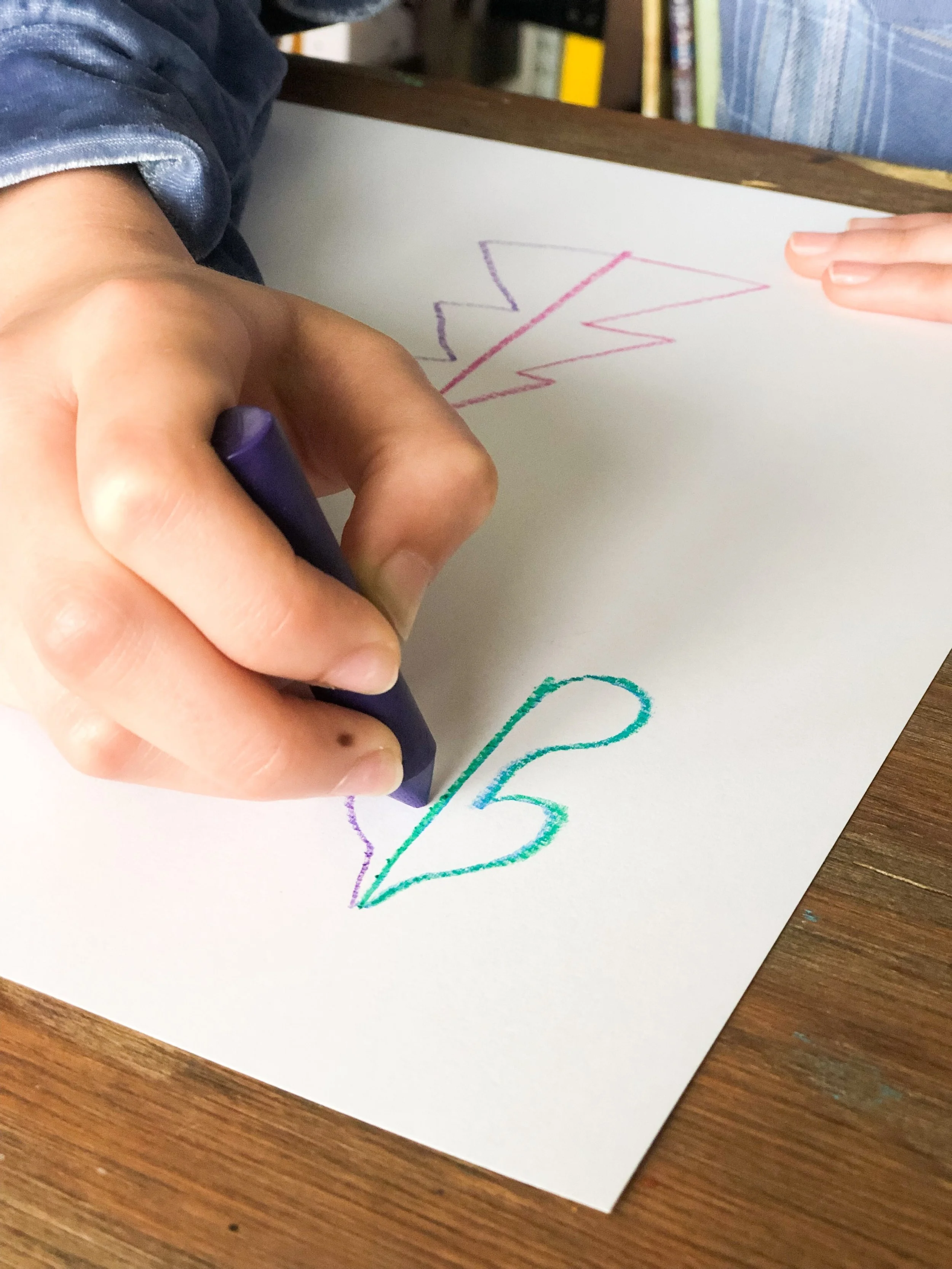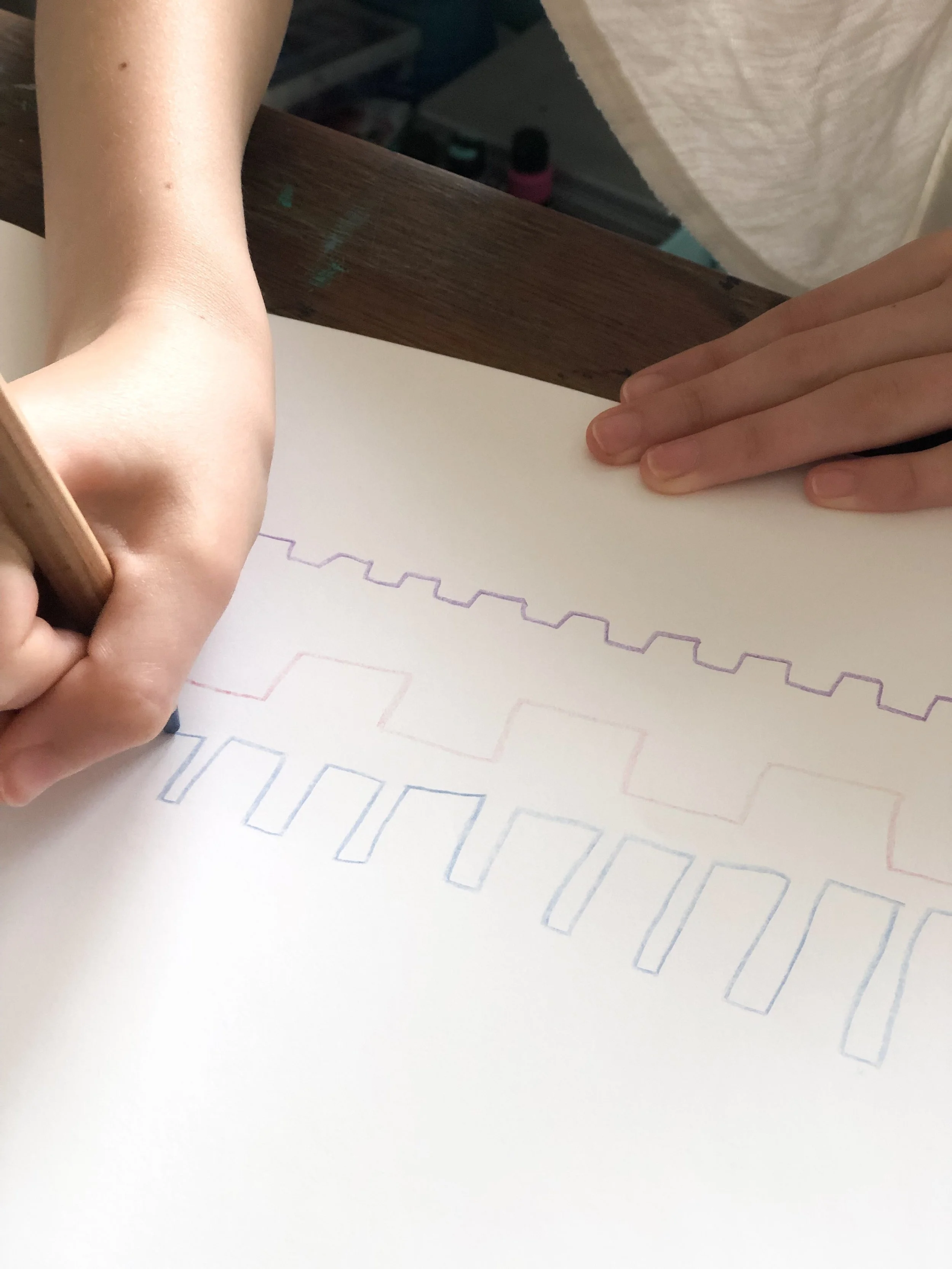
Waldorfish Blog
Waldorf Geometry: How it Meets the Sixth Grader
A running theme of the sixth grade Waldorf curriculum is the phrase “cause and effect.”
A twelve pointed circle becomes something beautiful with some color and shading!
Students at this age are ready to experience and observe more on their own than ever before, which is why we introduce the formal study of science, history, and more (and if you’re interested in learning more about the middle grades science, click here!)
My favorite subject to teach in sixth grade is geometry (not a big surprise to you, I’m sure!) It’s a block I look forward to, and deeply love, and not just because it speaks to me personally, but because I truly enjoy watching the transformation the materials create space for within the young middle schoolers.
The students have experienced geometry in fifth grade, so the subject isn’t completely new to them. They are familiar with the vocabulary, and have discovered and experienced the balance, symmetry, and beauty that freehand geometry provides.
In sixth grade, the geometry block brings a new experience for the student, and it's one that doesn’t always get the credit it deserves! But in my experience, it is perhaps the most important and developmentally appropriate block of sixth grade: it is all about cause and effect, the beauty of order, and the laws of nature.
So, how does the geometry curriculum reinforce the sixth grade theme of “cause and effect”?
If we’re constructing a six pointed form, the compass point must lay on the intended point as perfectly as possible. If it’s a little off, then the whole form will be a little unbalanced.
If we are constructing parallel lines and don’t use our straightedge accurately, then we simply won’t end up with parallel lines when we are done.
If we construct six equidistant points on a circle’s circumference, and connect them one by one with straight lines, then we’ll create a hexagon.
We include a string form lesson in our sixth grade geometry course!
Notice the “if….then…” wording?
If this, then that.
Rule, order, and natural consequences that exist without opinion or judgement- kind of perfect for a sixth grader, who probably feels judged often, unsure of where they stand in the world, and feels change all around them and in their physical body.
Truly feeling the reality of cause and effect, as well as the challenges and satisfaction that come with the experience of using tools and constructing complex forms, is deeply important for the student.
So what then is the significance of the next step, which is shading and using color to finish the final form?
This second step of using color and shading techniques, is a critical piece for the student to experience to truly get the benefits that this block provides. Now is the time to give them choice - what colors will they use? Bright, soft, bold, dark? Will the form be darker on the outer edges and get lighter as it moves in?
The choices are endless. When my students came to the point that a final form was ready to be finished with color, it never failed that the room would become quieter, students would arrange their pencils in possible color combinations, and careful, intentional work would begin. Beauty would begin to bloom around the classroom!
Student work displayed from a sixth grade classroom- every form and drawing is unique and beautiful!
Within the laws of nature, there is space for the beauty of the individual.
Isn’t that amazing, and so important for an-almost-teenager to experience?
For a sixth grader (or perhaps everyone?) it is important to hear and experience the comfort and structure that comes with knowing the laws of nature. We can count on these truths, and know that they will not waver, no matter how chaotic the world may seem. And within these laws, there is space for one to create beauty, and express their individuality in important and impactful ways.
I know these are big and lofty things to say about just one 3 or 4 week block, but I don’t say them lightly!
Geometry really is that powerful, meaningful, and just plain amazing.
Bring your homeschool curriculum to the place where art meets math! Our courses for grades 5-8 provide a full year’s worth of curriculum, instructor support, step-by-step instructions, and so much more.
About the Author
Caitlin Amajor taught in the Waldorf middle school for seven years, and was also a Waldorf student herself! She currently works as an administrative assistant for Waldorfish, and is also the instructor for the grades 5 and 6 geometry courses. Caitlin enjoys baking, gardening, and spending time with friends and family.
Waldorf Geometry :: Math in the middle grades
Ge•om•e•try | noun
Origin:
Middle English- via Old French from Latin “geometria”, from Greek, gē ‘earth’+ metria ‘measurement’.
Earth Measurement. This sounds like something entirely different from most of our own experiences with Geometry in school, yes?
Over thousands of years, geometry has become a standard part of math class and yet it sits in the modern math curriculum isolated from its true origin.
Ancient scholars, the first geometers, understood geometry to be the act of measuring the complete human experience of living on Earth. They set out on this study in order to understand the design behind everything they were experiencing in the physical world. In ancient Greece, the latin word “Mathematikos” meant “desire to learn” and the latin word “mathema” meant “knowledge/study.” In other words, the measurement and study of the physical world in order to understand the human experience on earth and how everything around us is created.
“Inspiration is needed in Geometry, just as much as in poetry.”
Rudolf Steiner and Waldorf education place the utmost importance on Geometry in the Waldorf curriculum, and have created a different path for students than the typical math curriculum offers.
In truth, in Waldorf schools children begin their study of “earth measurement” with their first lesson on the first day of first grade - by drawing straight lines and curved lines. Straight lines and curved lines are nature’s design tools and they will become the essential building blocks of writing and drawing.
Printing, cursive, numbers, and music notation are constructed with lines and arcs. As the students progress through the early grades, patterns of lines and arcs are part of almost every lesson. Where there are patterns, there is geometry. Clapping games establish rhythm and order. Eurythmy and dance involve expression by way of patterns in movement. Students sit in rows, circle up, and line up.
Waldorf geometry curriculum evolves as the child grows through grades 5-8!
Music and geometry go hand in hand as well. Rhythm, intervals, and patterns are the geometric design of music and poetry. As the students learn more about music, they can observe how different geometric patterns in music have unique qualities that induce a particular mood or feeling. Major chords sound “happy” and minor chords sound “sad.” The interval between a root note and the 5th sounds and feels much different than the interval between the root note and the seventh. Music is a great example of geometry as the tool behind the expression through sound. The idea of math as a universal language actually goes much deeper than numbers and calculations on paper being the same everywhere in the world. Ideally, a child’s education in the early grades is full of geometry.
Early experiences with Waldorf Geometry
In grades one through four, there is no formal geometry class. Geometry comes by way of everyday school life (music, writing, movement, etc) and Form Drawing class. Forms are patterns of straight and curved lines that become more complex as the children advance through the grades. Simple repeating forms in grades one and two help with the development of coordination for printing and cursive writing. More complex forms in grades three and four help to develop a sense of spatial awareness and symmetry. In the fourth grade, students practice forms that are also symbols from different cultures (i.e. Nordic symbols) and learn how to tie knots - a three dimensional version of the form drawings.
Try A Free Geometry Lesson
Moving into the middle grades
An example of a fifth grade freehand form with colored pencil.
Grade Five - Freehand Waldorf Geometry
Grade five is a special, transitional year, symbolic of the peek of childhood. The students study great civilizations of the past, including the “Golden Age” of Greece. The students themselves are in the golden age of childhood.
They are at the peak of their development in their child bodies and have gained as much mastery of their physical bodies as they are going to before heading into puberty. Fifth grade also marks the transition from form drawing to geometry. The goal of grade five “freehand geometry” is to lock the archetypal geometric forms into the body by drawing them without the use of tools. Classes also set out to find geometric forms in the world outside of their classrooms.
(Learn more about fifth grade geometry here!)
This form begins with twelve points on a circle- all constructed with a compass and straightedge!
Grade Six - Geometric drawing tools
With the arrival of adolescence, grade six becomes a year of re-birth both physically and in the curriculum. In geometry, we need to go all the way back to the beginning with straight lines and curved lines. This time, however, the children learn to construct lines and arcs with geometric drawing tools. A straightedge (ruler) constructs a line and a compass constructs an arc. The students will now begin a second journey through geometry that mirrors grades 1-5. The three-fold approach to learning (doing, feeling, thinking) is beautifully displayed in the geometry curriculum. In grade 6, the focus is on the physical doing aspect of learning. Learning to use tools to construct and measure is a physical task and it challenges the students as they begin to develop new physical bodies. The focus on “doing” in grade six mirrors the 1st and 2nd grade curriculum where an understanding of lines, arcs, and patterns comes from drawing forms with both the hands and feet, walking patterns, and rhythmic clapping games, etc.
(Learn more about sixth grade geometry here!)
Seventh grade geometry curriculum weaves into history, art, mathematics, human anatomy, and more!
Grade Seven - Inward and outward exploration
Grade Seven in Waldorf schools is generally thought of as “the year of exploration.” A seventh grader, now fully immersed in adolescence, is ready to outwardly explore the physical world and inwardly begin an exploration of the question “who am I?” The feeling life of the seventh grader takes center stage in the curriculum as we use geometry to understand the human body and the natural world we live in. Da Vinci’s Vitruvian Man and the work of Fibonacci give us clues about the mathematical formula behind all that is living on our planet. It’s an incredible moment when students discover that the same ratios and patterns found in pentagrams, roses, apples, insects, hurricanes, and the milky way galaxy, are also found in the structure of our own bodies. The observational studies of nature performed by the likes of Plato, Pythagoras, Eratosthenes, Fibonacci, and Leonardo Da Vinci are mirrored by the observational powers of the seventh grader (they see everything, yes?).
Grade Eight - Digging deeper
In grade eight, the geometry curriculum enters the thinking realm. Armed with knowledge about how to use the tools of the geometer and the experience of searching for one’s self both in nature and the human body, the students are ready to become mathematicians, in the ancient Greek spirit of the mathematician being one who studies all things.
Eighth grade geometry works with 3D forms- both on paper and with hands-on modeling!
We can now venture into the world of abstract thought and theory. The students will grapple with how to measure and study the three dimensional world on the two dimensional surface of the paper. By the 8th grade, it is the hope that students can see that there is always more than meets the eye, and they now have the physical and intellectual tools to dig deeper through observation, making precise measurements and calculations, and articulately describing what they see. They are mathematicians, scientists, and philosophers training to see things on multiple levels.
On one level, numbers define quantities and help us with measurements and calculations. On another level, each number has its own unique set of qualities. Like the circle, the number one represents wholeness and the beginning. Plato called the circle “the mother of all shapes.” When the whole is cut into two, polarities are created (up, down, left, right, life, death, hot cold, positive, negative, male, female, etc.). The number three has a very balanced quality (tripods, tricycles, triangles). This way of understanding the quality of numbers is similar to the phenomenological way of teaching science. When a botany student imagines a plant, the goal of the teacher is to get the child to have a fluid mental picture that includes the entire life cycle of the plant, as opposed to just a fixed image of the plant in a particular moment in time.
With geometry, the goal for the 8th grader is to help them think of numbers not just as quantities but as parts of patterns in nature with their own qualities that shape the world around us and our experience of the world.
“Let no one ignorant of geometry come under this roof.”
•We created a 3 page Qualities of Numbers reference guide for you! Tell us where to send yours in the form below. It’s free!
•We offer a comprehensive Geometry curriculum, covering the grades 5-8.
Related content:
What is Form Drawing?
Form drawing is a cornerstone of Waldorf curriculum in grades 1-4.
I will freely admit to anyone that knows what Waldorf form drawing is that I was terrified to bring it into a homeschool environment.
What, exactly, was encoded in those mysterious lines and shapes? What esoteric wisdom did I need to attain before I could try to impart this practice to my son? Like most things I fear, the answers were not as complicated as I originally thought.
“The child’s capacity to develop an integrated sense for spatial orientation – upwards, downwards; left, right; center, periphery – is supported in the practice of form drawing.”
Form drawing, it turns out, is a brilliant way to work with one’s senses...senses being of great importance in a Waldorf education. Paper and pencil serve as a lantern, illuminating our inner selves, the forms creating a blueprint of our inner (and outer) orientation.
" Rudolf Steiner, in his many lectures on this subject, speaks of twelve senses. Added to the usual five, there is a human sense for rhythm, warmth, balance, movement and so on..."
- The Incarnating Child, pg. 73
Form drawing is a beautiful way to bring color and form together.
Beginning in first grade and extending throughout her time at a Waldorf school, a student engages in drawing exercises that range from very simple to very complex, according to her grade and various topics of study. Straight and curved lines form the foundation for letters in 1stgrade, for Celtic knots in 4th and Geometry in middle school. Over and over, drawing both imparts knowledge and folds it back into oneself.
"Straight lines and curves are the starting points for form drawing. This begins with the discovery that the line is a path along which one can move. Children should experience the characteristic difference between straight lines and curves through drawing them, after having explored their character through whole bodily movement in space."
- The Tasks and Content of the Steiner-Waldorf Curriculum, p.137
Much can be ascertained about the form drawer from this kind of work, and the analytical angle is an important one. There is, however, another important aspect of Form Drawing that should not be overlooked: it’s a lot of fun. As soon as I embraced form drawing as the journey itself (instead of a perfect form being the destination), our weekly work became something to look forward to.
Don't forget to practice!
Forms can and should be returned to time and again for a variety of reasons that will become clear to you as you study, draw, reflect, and repeat. Remember that they are not about achieving anything in particular. Think of them as a friendly guide.
Form drawing is a deep ocean that one could spend an entire lifetime learning to navigate. Don’t let this stop you from jumping in. Buy a book, look up #formdrawing on social media and reach out to people whose ideas are of interest to you, but most importantly pick up a pencil, chalk, stick or block crayon, suspend your judgment, and encourage your child to do the same.
This radical act of trust in the power of art to teach and transform is the lynch pin of Waldorf Education.
Try a Free Form Drawing lesson!
About the Author
Cristina Havel lives in Southern California where she and her husband have worked together for nearly 2 decades. They homeschool their son using the Waldorf pedagogy as a guide and believe in the transformative powers of art and nature.
Related content:
New course line-up!
We've finalized our course offerings for our next school year!
Individual info pages for each one will be available soon on our website. For those who, like us, get a little twitchy with all the waiting, here's what we know for certain .....
Geometry
Photo credit: Jessica Richardson
Brian is teaming up with fellow Waldorf teacher, Caitlin Amajor, for this G5-8 series! We have a FAQ page here, where you can learn more about this artistic, inspired program. Registration opens on July 15th! Courses begin on Sept. 3rd. There is also a link to a new free lesson on the FAQ page.
Grade One wet-on-wet painting
Waldorf teacher Amanda Mercer has been busy creating a beautifully supportive program for the Waldorfish community! This video series will guide parents & teachers on a journey through each primary color via wet-on-wet painting techniques & original verses. G2 and G3 courses are in the pipeline as well, although release dates for these are not set yet. The G1 course is OPEN for enrollment! Learn more about it, here!
Photo credit: Amanda Mercer
For the 2018/2019 school year we are pulling together our favorite lessons from the first two sessions of this program! This collection will be perfect for families who have not participated in WA previously. As in prior sessions, the lessons will post x1 per week, and Brian & I will be actively involved in the classroom. Registration will open July 15th, the course will begin August 10th. (see updated info, here!)
Festival Art
We're teaming up with storyteller Sara Logan for this new course! 10 original/adapted stories paired with art lessons to carry your family through the full circle of a festival year!! This course is ideal for families who have previously participated in the Weekly Art program, or those looking for less frequent art lessons than offered in our other programs. NOTE: this program will initially only be available to WA students currently enrolled in the '17-18 session. It will become available to the whole community in time for the '18 Advent season!
As always, send us your thoughts + questions by emailing us at support@waldorfish.com
All our best to you from the garden,
~Robyn (& Brian nearby) Wolfe
Looking for something?
Welcome to Waldorfish! We started this adventure in 2012 out of a desire to make Waldorf training more accessible to class teachers in remote locations and to homeschooling families everywhere! Read more, click here.
WE WON! Our Weekly Art courses were voted “best interactive art program.” Learn more about the award, here.
A few of our most popular blog posts:


